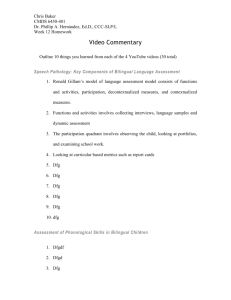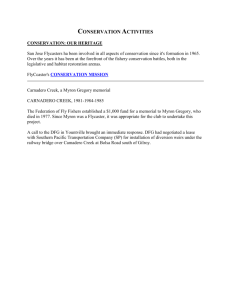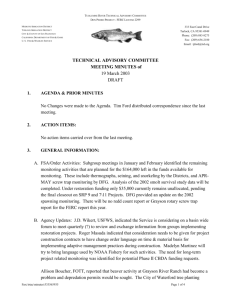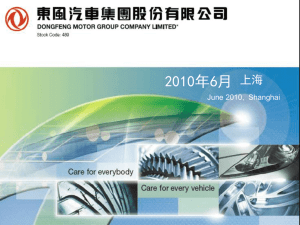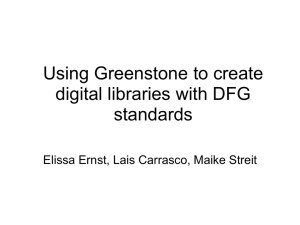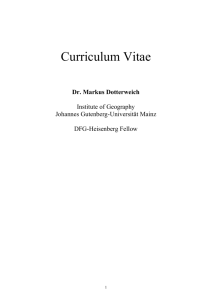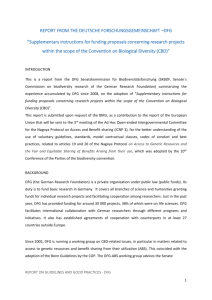Folie 1 - National Commission on Research, Science and Technology
advertisement
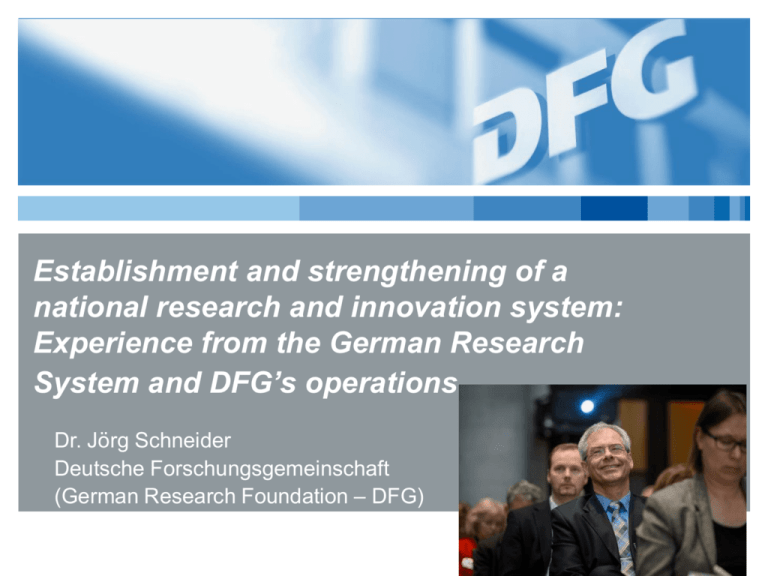
Establishment and strengthening of a national research and innovation system: Experience from the German Research System and DFG’s operations. Dr. Jörg Schneider Deutsche Forschungsgemeinschaft (German Research Foundation – DFG) Warning ….. Statistics – at least recent statistics – are difficult to obtain. Therefore, some of the figures are more educated guesses…. But always good enough to make the point I want to make. 2 joerg.schneider@dfg.de ! Innovation System – a healthy tree … R&D products for Society, Economy, Health, Environment… …fed by pre-competitive applied research, problem-driven… … and growing on basic research, science-driven 3 … if provided for adequately! Top down funding, problemoriented € € € € € Advice for politics And society Supply of food, Water, energy Sound bio- Healthcare Industrial diversity Clean & healthy products environment € € € € € € € € € € € 4€ € € € € € € € € € € € € € € € € € € € € € € € € €€ € € € € € € € Bottom up funding, quality-oriented, but no thematic programmatics! R&D Expenditures in Germany 2011 (estimated according to BMBF Report 2014) 84 Mrd. € for R & D Federal 16,4 Joint Funding States: 2,3 Federal: 5,1 Federal progr., problem-oriented 7,7 5 joerg.schneider@dfg.de States 13,3 Enterprises 51,5 Other 2,8 Universities Länder: 8 (+10 for educ.) Bund: 1,1 DFG MPG WGL HGF FhG … Federal Research Institutes 1,7 International Research Institutes 1,0 Lissabon-Agreement: 3% of European GDP for R&D ► In March 2000, the European Council decided, during its Summit in Lissabon, to develop Europe into “the most competitive and the most dynamic knowledge-based economy in the world” by 2010. ► In order to achieve this ambitious aim, two major measures were decided: 1. To increase employment throughout Europe 2. To increase R&D expenditure upt to 3% of GDP ► Germany is close, the Government wants more, but….. 6 joerg.schneider@dfg.de Gross domestic expenditure on RD in selected countries It is important that the private sector takes responsibility! % GDP Japan 2013 76% China (VR) 2013 75% Korea (Rep.) 2011 74% Germany 2012 29% 61% Switzerland 2012 61% 25% Finland 2013 61% 26% OECD 2012 60% 30% USA 2012 59% 31% 28% 55% 54% Singapore 2012 53% Canada 2012 South Africa 10% Business enterprise Government 50% 60% Other national sources 12% 3,0 % 12% 3,3 % 2% 5% 4% 6% 2,8 % 2,2 % 8% 1,9 % 2% 6% 2,0 % 6% 1,7 % 20% 3% 2,4 % 10% 3% 45% 40% 3,3 % 12% 29% 30% 7% 6% 13% 1,6 % 0,8 % 0% 2% 0,1 % 79% 20% 2,9 % 5% 34% 20% 0% 2% 39% 38% Namibia 2010 2% 34% 46% 0%4% 4% 35% 47% UK 2012 1% 0% 4,0 % 25% Sweden 2013 EU 28 2012 3%1% 2,0 % 21% 66% France 2012 7% 1% 3,5 % 17% 70% 80% 90% 100% Abroad Datenquelle: OECD (2015), Main Science and Technology Indicators, Vol. 2014/2, OECD Publishing, Paris. Zu Singapur und Namibia: http://data.uis.unesco.org 7 joerg.schneider@dfg.de Triadic patent families in selected countries 2011 total number Japan United States Germany France Korea UK China Netherlands Switzerland Sweden Italy Canada Belgium Austria Israel Finland Denmark Australia India Spain Norway Ireland Russian Federation New Zealand Brazil Hungary South Africa Turkey number per million inhabitants 76% Japan 61% Switzerland 61% Sweden 66% Germany 61% Finland Netherlands Denmark 59% USA Israel Austria Korea (Rep.) 55% France Belgium Luxembourg UK 46% Norway Ireland 47% Canada Italy 0 2000 4000 6000 8000 10000 12000 14000 Australia New Zealand Triadic: patents are registered in Europe, Japan & US Source: OECD (2014) http://dx.doi.org/10.1787/factbook-2014-63-de 8 joerg.schneider@dfg.de Iceland Spain Slovenia Hungary Estonia Czech Republic 0 20 40 60 80 100 120 Major Players within German Research System (simplified!!!) Federal Government Länder Governments DFG Higher Education Sector HGF MPG Federal institutions performing R&D Länder instituitions performing R&D FhG WGL Academies Federation of Industrial Cooperative Research Associations 9 joerg.schneider@dfg.de Institutional funding Federal Government Länder Private sector Project funding Federal Government Private sector DFG Intramural research laboratories Business enterprise sector Source: BuFo 2000 Research -Funders -Performers Why is the German system so complicated? 1. Deutsches Grundgesetz (German Constitution) in Article 5 (Basic Human Rights): The arts and sciences, research and education are free. Thus, the Governments have to provide free money! 2. On the other hand, the Governments have to ensure problem-oriented research (competitiveness of economy, well-being of citizens and nature). 3. Finally: according to the Grundgesetz and the principle of subsidiarity the responsibility for science and education (and for the universities) lies with the Länder (federal states), not the Federal Government. 10 joerg.schneider@dfg.de What does it mean for research (funding)? • Nearly all universities belong to the 16 federal states, funding for teaching and basic funding for research from states, not from federal government! • Due to the German Constitution (Grundgesetz), the Federal Government is not allowed to support universities directly, very few exceptions which have to be legalized by treaties between federal government and all 16 states! • Extra-university research institutes (Max-Planck, Fraunhofer, Helmholtz, Leibniz) are jointly funded by federal and state governments (as regulated by constitution, law and several by-laws). Conclusion: it may look complicated, but it is a very well ballanced interplay between several key (f)actors 11 joerg.schneider@dfg.de Major Players within German Research Funding (simplified!!!) Federal Government Länder Governments DFG Higher Education Sector HGF MPG Federal institutions performing R&D Länder instituitions performing R&D FhG WGL Academies Federation of Industrial Cooperative Research Associations 12 joerg.schneider@dfg.de Institutional funding Federal Government Länder Private sector Project funding Federal Government Private sector DFG Intramural research laboratories Business enterprise sector Source: BuFo 2000 Research -Funders -Performers Division of tasks within the public system Institutional funding Project funding 13 joerg.schneider@dfg.de Problem-driven research Science-driven research • • • • • • • • • Leibniz Institutes Helmholtz Institutes Federal Research Inst. Joint Research C. EU AiF Member Institutes Max-Planck Institutes Fraunhofer Institutes CERN EMBL • Ministerial Funding Pro- • DFG rams (e.g. Water • Fellowship programs management, Biotech) (DAAD, AvH, EU-Marie • EU Funding Prg. (e.g. Curie) Car of the Future, • European Research Cardiovascular Council (ERC) Diseases) German Research System – publically funded ► Federal Government – top down thematic programs ► Federal Government – DAAD and AvH ► Federal Government – federal ministerial research institutes ► Länder Governments – universities ► Länder Governments – federal ministerial research institutes ► Both together – Joint funding of ● German Research Foundation DFG ● Max Planck Society ● Fraunhofer Society ● Helmholtz Association ● Leibniz Association ● various smaller institutions ► Further joint efforts to strengthen innovation system 14 joerg.schneider@dfg.de R&D Budgets of Federal Ministries 15 joerg.schneider@dfg.de Source: Federal Report on Research and Innovation 2014, BMBF Research project funding by Federal Ministries 16 joerg.schneider@dfg.de Source: Federal Report on Research and Innovation 2014, BMBF German Research System – publically funded ► Federal Government – top down thematic programmes ► Federal Government – DAAD and AvH ► Federal Government – federal ministerial research institutes ► Länder Governments – universities ► Länder Governments – federal ministerial research institutes ► Both together – Joint funding of ● German Research Foundation DFG ● Max Planck Society ● Fraunhofer Society ● Helmholtz Association ● Leibniz Association ● various smaller institutions ► Further joint efforts to strengthen innovation system 17 joerg.schneider@dfg.de Mobility Funding by Federal Government mobility of students/education sector mobility of researchers Federal Foreign Office Fed. Min. Education & Research Fed. Min. Economic Coo. & Development European Commission (Erasmus ….) Other Sources 184 Mio € 101 Mio € 40 Mio € 60 Mio € 45 Mio € Total budget 430 Mio € (2014) 110 Mio € (2013) 18 joerg.schneider@dfg.de 38 Mio € 60 Mio € 6 Mio € 6 Mio € German Research System – publically funded ► Federal Government – top down thematic programmes ► Federal Government – DAAD and AvH ► Federal Government – federal ministerial research institutes ► Länder Governments – Universities ► Länder Governments – federal ministerial research institutes ► Both together – Joint funding of ● German Research Foundation DFG ● Max Planck Society ● Fraunhofer Society ● Helmholtz Association ● Leibniz Association ● various smaller institutions ► Further joint efforts to strengthen innovation system joerg.schneider@dfg.de 19 Institutions of Higher Education IHE . . % of Students Universities of Applied Sciences 65% of students 108 Universities 31% of students In Germany (2012): 427 IHE with 2,5 Mio. students 26 % IHE are universities (108) with 65% of all students 74% IHE are Universites of Applied Sciences – Fachhochschulen and similar 46% pupils from one year go to IHE PhD can only be granted by Universites Universities Source: Federal Statistics Bureau 20 joerg.schneider@dfg.de R&D at German Universities – Third Party Funding 2012 DFG Federal Government Basic funding for R&D by Länder: about 10 Bil. € Private Sector European Union Foundations Länder Total 21 joerg.schneider@dfg.de joerg.schneider@dfg.de Source: www.statista.com German Research System – publically funded ► Federal Government – top down thematic programmes ► Federal Government – DAAD and AvH ► Federal Government – federal ministerial research institutes ► Länder Governments – universities ► Länder Governments – federal ministerial research institutes ► Both together – Joint funding of ● German Research Foundation DFG ● Max Planck Society ● Fraunhofer Society ● Helmholtz Association ● Leibniz Association ● various smaller institutions ► Further joint efforts to strengthen innovation system 22 joerg.schneider@dfg.de Research Organizations: Max-Planck Society ► 80 Institutes ► Budget: 1.8 B € ► 17,000 employees incl. 5,200 scientists ► plus 13,400 „students“ ► Central Administration with 500 admin. staff ► Mission: high quality basic research - „Nobel Awards“ 23 joerg.schneider@dfg.de Basic research Harnack-prinziple Research Organizations: Fraunhofer Society ► 66 Institutes ► Budget: 1.9 B € ► 22,000 employees ► Incl. 6,403 „students“ ► Central Administration with 300 admin. staff ► Mission: high quality applied research - „earn money“ 24 joerg.schneider@dfg.de applied research 30/30/40 Research Organizations: Helmholtz Association ► 18 Institutes ► Budget: 3.8 B € ► 33,000 employees ► Incl. 16,000 scientists ► Central Office with 70 admin. staff ► Mission: high quality problem-oriented, longterm research 25 joerg.schneider@dfg.de Long term Large instruments Research Organizations: Leibniz Association ► 86 Institutes ► Budget: 1.5 B € ► 17,000 employees ► Incl. 8,000 scientists ► Central Office with 60 admin. staff ► Mission: high quality problem-oriented research 26 joerg.schneider@dfg.de Regular independent evaluation German Research System – publically funded ► Federal Government – top down thematic programmes ► Federal Government – DAAD and AvH ► Federal Government – federal ministerial research institutes ► Länder Governments – universities ► Länder Governments – federal ministerial research institutes ► Both together – Joint funding of ● German Research Foundation DFG ● Max Planck Society ● Fraunhofer Society ● Helmholtz Association ● Leibniz Association ● various smaller institutions ► Further joint efforts to strengthen innovation system 27 joerg.schneider@dfg.de Pact for Research and Innovation Pakt für Forschung und Innovation The Pact for Research and Innovation is designed to give financial planning security to institutions that are jointly funded by the Federal Government and the Länder (states): ► Max Planck Society MPG ► Fraunhofer Society FhG ► Helmholtz Association HGF ► Leibniz Association WGL ► German Research Foundation DFG 2005 – 2010: Budget increase of 5% every year 2011 – 2015: Budget increase of 5% every year 2016 – 2020: Budget increase of 3% every year 28 joerg.schneider@dfg.de Higher Education Pact 2020 Hochschulpakt 2020 Pillar 1: Program for the admission of additional university entrants 2007 – 2023 Federal Government invests 20.3 billion € states invest 18.3 billion € for new university places for students Not for research!!!! !!! Pact 2020 come on top of Quality Pact for Teaching !!! 2011 – 2020 Federal Government provides 2 billion € for the improvement of teaching at universities 29 joerg.schneider@dfg.de Higher Education Pact 2020 Hochschulpakt 2020 Pillar 2: Program allowances (overheads) for projects funded by DFG 2010 – 2015 2.3 billion € as pilot project exclusively by Federal Government for 20% overheads on DFG project funding 2016 – 2020 2.2 billion € now jointly 20% by Federal Government 2% by state governments together (according to Königstein Key) 30 joerg.schneider@dfg.de Excellence Initiative Top-class research for even better competitiveness 2005 – 2011 1.9 billion € 2012 – 2017 2.7 billion € 2017 – ??? similar investments 75% Federal State 25 % host state of funded institution 2005 – 2017; currently funded: ► 45 Graduate Schools ► 43 Clusters of Excellence ► 11 Institutional Strategies 31 joerg.schneider@dfg.de December 2014 – a Turning Point in German Research Funding ► Both Houses of the German Parliament agree on loosening the constitutional prohibition of long-term federal investments in university research! ► From 2015 on, Federal Government will cover annual budget of the states for students support 1,2 billion € in 2015. Condition: states have to invest money in education 32 joerg.schneider@dfg.de German Research System – publically funded ► Federal Government – top down thematic programmes ► Federal Government – DAAD and AvH ► Federal Government – federal ministerial research institutes ► Länder Governments – universities ► Länder Governments – federal ministerial research institutes ► Both together – Joint funding of ● German Research Foundation DFG ● Max Planck Society ● Franhofer Society ● Helmholtz Association ● Leibniz Annsociation ● various smaller institutions ► Further joint efforts to strengthen innovation system 33 joerg.schneider@dfg.de Joint Funding Institution Helmholtz Fraunhofer Max Planck Leibniz DFG (basic funds) DFG (Excellence In.) DFG (20% overheads) DFG (22% overheads) DFG (large equipment) Academies' Program Leopoldina Wissenschaftskolleg Research at FHs 34 joerg.schneider@dfg.de Federal : States share of Länder (federal states) 90 : 10 host state 90 : 10 66% host state, 33% according to Königstein key (of 30 %!!!!!) 50 : 50 50% host state, 50% according to Königstein key research 75% host state, 25% according to Königstein key institutes 50 : 50 service 25% host state, 75% according to Königstein key institutes 58 : 42 according to Königstein key 75 : 25 host state 100 : 0 No share from 2016 ! 91 : 9 according to Königstein key 50 : 50 Host state 50 : 50 host state 80 : 20 host state 50 : 50 host state 100 : 0 no share Königstein Key (2010) Federal State Share in % Federal State Share in % Baden-Würtemberg 12,81503 Niedersachsen Bayern 15,19297 Nordrhein-Westfalen Berlin 5,03822 Rheinland-Pfalz 4,81284 Brandenburg 3,10452 Saarland 1,23114 Bremen 0,93119 Sachsen 5,16869 Hamburg 2,54537 Sachsen-Anhalt 2,92874 Hessen 7,22575 Schleswig-Holstein 3,37218 Mecklenburg-Vorpommern 2,08237 Thüringen 2,79484 Sum 35 joerg.schneider@dfg.de 9,31388 21,44227 100% DFG is driven by scientific demand ► DFG acts and funds bottom up ► no thematic priorities (rare exceptions) ► no regional priorities ► no political priorities ► no political influence ► everything decided by scientists ► everything in competition ► everything in peer review ► Funding only if institution agrees on ethical standards 36 joerg.schneider@dfg.de DFG‘s Funding Instruments – all open to international co-operation and to foreign researchers working in Germany International Scientific Contacts Promoting Young Researchers Infrastructure ► Research Fellowships ► One‘s own position Funding Programmes ► Emmy Noether-Programme ► Heisenberg-Programme Coordinated Programmes ► Research Units ► Priority Programmes Individual Grants ► Individual Research Grants ► Mercator Guest Professorships ► Reinhard Koselleck-Projects 37 joerg.schneider@dfg.de Awards ► Collaborative Research Centres ► Gottfried Wilhelm Leibniz-Prize ► International Research Training Groups ► many more ► Excellence Initiative DFG is driven by scientific demand ► DFG acts and funds bottom up ► no thematic priorities (rare exceptions) ► no regional priorities ► no political priorities ► no political influence ► everything decided by scientists ► everything in competition ► everything in peer review ► Funding only if institution agrees on ethical standards 38 joerg.schneider@dfg.de How is the DFG structured? General Assembly (members!) establishes directives approves annual report and account approbates the Executive Committee elect, select, appoint cooperate Senate (36+3 scientists) Joint Committee (Senate & 17/32 Governmental representatives) Executive Commitee Ex. Board & 8 VicePresidents 48 Review Boards (elected!) Executive Board President Secretary General Head Office Reviewers assess funding proposals All eligible scientists and academics 39 joerg.schneider@dfg.de ensure quality President + 8 vice-presidents of DFG Executive Committee Presidents (since1980) E. Seibold (1980 - 1985) H. Markl (1986 - 1991) W. Frühwald (1992 - 1997) E.-L. Winnacker (1998 - 2006) M. Kleiner (2007 - 2012) Vizepräsidenten M. Famulok (Chemistry) P. Funke (History) W. Ertmer (Physics) K. Becker (Biology) L. BrucknerTuderman (Medicine) M. Hochbruck (Mathematics) W. Schön (Law) Peter Strohschneider Secretary General: Ms Dorothee Dzwonnek 40 joerg.schneider@dfg.de F. Allgöwer (Engineering) M. Barner, President German Founders Association, Guest DFG is driven by scientific demand ► DFG acts and funds bottom up ► no thematic priorities (rare exceptions) ► no regional priorities ► no political priorities ► no political influence ► everything decided by scientists ► everything in competition ► everything in peer review ► Funding only if institution agrees on ethical standards 41 joerg.schneider@dfg.de The DFG´s Head Office Internal Advisory Committee Extended Executive Board Heads of Divisions and Executive-Level Offices Press and Public Relations Executive Offices Executive Board President Secretary General Forum Heads of Divisions Deputy Members: Heads of Departments I to III Economics and Auditing Quality Assurance and Programme Development International Affairs Berlin Office Department III Department I Central Administration Budget and Accounting Human Resources/Legal Affairs Information Technology and Infrastructure Information Management Administrative Support for DFG Offices joerg.schneider@dfg.de 42 Department II Scientific Affairs Humanities and Social Sciences Life Sciences 1 Life Sciences 2 Physics, Mathematics, Geosciences Chemistry and Process Engineering Engineering Sciences Coordinated Programmes and Infrastructure Research Centres Research Careers Scientific Library Services and Information Systems Scientific Instrumentation and Information Technology DFG is driven by scientific demand ► DFG acts and funds bottom up ► no thematic priorities (rare exceptions) ► no regional priorities ► no political priorities ► no political influence ► everything decided by scientists ► everything in competition ► everything in peer review ► Funding only if institution agrees on ethical standards 43 joerg.schneider@dfg.de DFG is driven by scientific demand ► DFG acts and funds bottom up ► no thematic priorities (rare exceptions) ► no regional priorities ► no political priorities ► no political influence ► everything decided by scientists ► everything in competition ► everything in peer review ► Funding only if institution agrees on ethical standards 44 joerg.schneider@dfg.de International cooperation for setting the right perspective! Major task: working on framework conditions for optimal international cooperation for German researchers 45 joerg.schneider@dfg.de Global forum for non-ministerial research (funding) organizations Internationally: Cooperate on joint standards of projects selection, scientific conduct, general ethics, open access, Brain circulation, IPR, ….. Annual Regional Meeting Sub-Saharan Africa 2014 – 2016(?) 46 joerg.schneider@dfg.de Advocating basic research once again and finally…… Top down funding, problemoriented Advice for politics Supply of food, And society Water, energy Sound bio- Healthcare Industrial diversity Clean & healthy products environment No basic research: Results have to be brought in from an outside system! Same is true for students!!!!! 47 GDP and Expenditure on R&D (GERD) per capita in selected countries, 2011 or in the most recent year GDP per capita in current PPP$ GERD per capita in current PPP$ Singapore 2011 Finland 2011 Switzerland 2008 Sweden 2011 USA 2011 Switzerland 2008 Canada 2011 Sweden 2011 USA 2011 Germany 2011 Singapore 2011 Finland 2011 UK 2011 Korea (Rep.) 2011 France 2011 Germany 2011 Japan 2011 Japan 2011 Korea (Rep.) 2011 South Africa 2010 France 2011 China 2011 Canada 2011 Namibia 2010 UK 2011 0 10,000 20,000 30,000 40,000 50,000 60,000 PPP$: adjusted to purchasing power 70,000 China 2011 South Africa 2010 Namibia 2010 0 Source: http://data.uis.unesco.org, datasets: demographic and socioeconomic, science,technology and innovation 48 joerg.schneider@dfg.de 500 1000 1500 Gross expenditure on R&D (GERD) in selected countries South Africa 2010 Kenya 2010 Nigeria 2007 Tanzania 2010 Uganda 2010 Ethiopia 2010 United States 2012 China 2012 Japan 2011 Germany 2012 Korea 2011 France 2012 UK 2012 Canada 2012 Sweden 2012 Switzerland 2008 Finland 2012 Singapore 2012 South Africa 2010 Namibia 2010 Sudan 2010 Ghana 2010 Senegal 2010 Gabon 2009 Botswana 2005 Mali 2010 Mozambique 2010 Zambia 2008 Mauritius 2005 Burkina Faso 2009 Madagascar 2011 Namibia 2010 Togo 2010 0 200 Burundi 2011 400 Gambia 2011 Millions Congo 2009 Cabo Verde 2011 Lesotho 2011 Datenquelle: http://data.uis.unesco.org, Dataset: Science, technology and innovation. Indicator GERD in '000 current PPP$. 0 1 2 3 4 Millions Das Wissenschaftssystem in Deutschland, Dr. Jörg Schneider 49 Bonn, März 2015 Thank you very much for your attention Dr. Joerg Schneider Head of International Division Deutsche Forschungsgemeinschaft joerg.schneider@dfg.de 50 joerg.schneider@dfg.de
